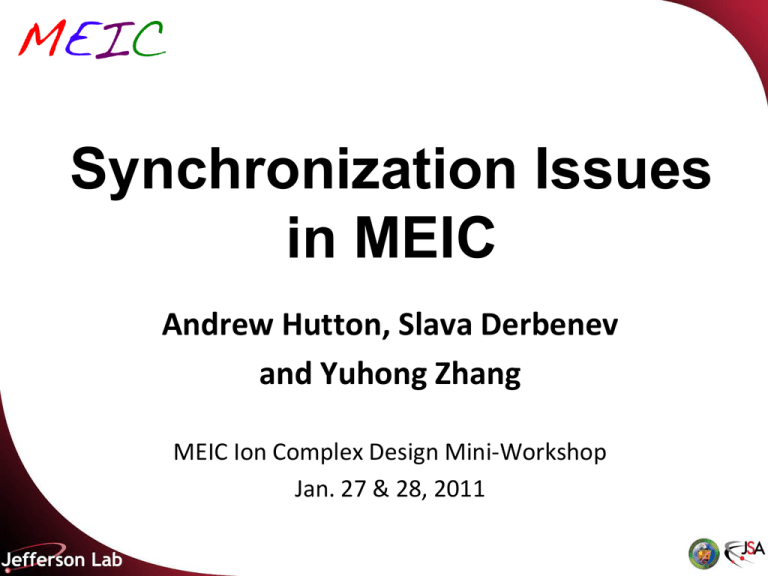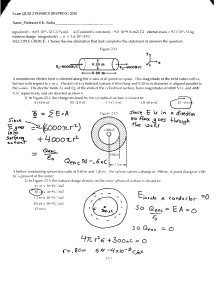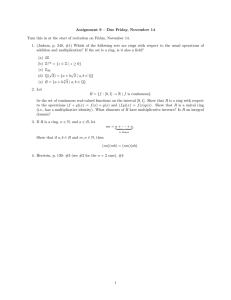MEIC Beam Synchronization
advertisement

Synchronization Issues in MEIC Andrew Hutton, Slava Derbenev and Yuhong Zhang MEIC Ion Complex Design Mini-Workshop Jan. 27 & 28, 2011 The Problem • Electrons travel at the speed of light • Protons and ions are slower • There are three areas that need to be addressed • In collider ring matching electron & ion beams at multiple IPs • During acceleration • Cooling matching ion beam and cooling electron beam • Assumptions • MEIC collider ring circumference is around 1 km • Large booster (LEIC) is the same circumference as MEIC • Electron ring is the same circumference as MEIC • Superconducting RF systems have limited frequency swing Harmonic Numbers • Assuming circumference of the MEIC collider ring is about 1 km • For an RF frequency of 1497 MHz • The best harmonic number is 4860 = 2x2x3x3x3x3x3x5 • Corresponds to a circumference of 971.98 meter • For an RF Frequency of 748.5 MHz • The harmonic number is 2430 • For an RF Frequency of 499 MHz • The harmonic number is 1620 Orbit Differences in MEIC • MEIC design parameters Proton energy 20 to 60 GeV Deuteron energy 10 to 30 GeV/u Lead energy 7.9 to 23.8 GeV/u Bunch repetition rate 748.5 MHz Collider ring circumference ~1000 m Harmonic number 2500 • Orbit difference from 1000 m ring @ 60 GeV proton design point proton 60 GeV design point 20 GeV -97.9 cm 2.44 bunch spacing deuteron: 30 GeV/u -36.7 cm 0.92 bunch spacing 10 GeV/u -429 cm 10.7 bunch spacing Lead: 23.8 GeV/u -65.7 cm 1.64 bunch spacing 7.9 GeV/u -692cm 17.3 bunch spacing • MEIC Circulator Cooler Energy range 4.3 to 32.7 MeV γ 8.4 to 63.9 β 0.9929 to 0.9999 2 unit of HN 1 unit of HN 11 unit of HN 2 unit of HN 17 unit of HN Bunch repetition rate 748.5 MHz Circulator ring circumference ~ 50 m Harmonic number 125 Orbit difference cooling proton@20 GeV/u -4.9 cm 0.1 wavelength no change of HN cooling lead@7.9 GeV/u -35 cm 0.86 wavelength 1 unit of HN Harmonic Number vs. Proton Energy Rest mass of Proton Circumference RF Frequency MHz Harmonic number h n 0 1 2 3 4 5 6 7 8 9 10 11 12 13 14 Beta 1 0.9998 0.9996 0.9994 0.9992 0.9990 0.9988 0.9986 0.9984 0.9981 0.9979 0.9977 0.9975 0.9973 0.9971 1497 4860 Energy 45.32 31.77 25.77 22.19 19.75 17.95 16.55 15.42 14.49 13.70 13.02 12.42 11.90 11.43 0.9383 GeV/c2 971.98 meters 748.5 2430 499 1620 Beta Energy 1 0.9996 31.77 0.9992 22.19 0.9988 17.95 0.9984 15.42 0.9979 13.70 0.9975 12.42 0.9971 11.43 0.9967 10.63 0.9963 9.97 0.9959 9.41 0.9955 8.93 0.9951 8.51 0.9947 8.14 0.9942 7.82 Beta Energy 1 0.9994 25.77 0.9988 17.95 0.9981 14.49 0.9975 12.42 0.9969 11.01 0.9963 9.97 0.9957 9.17 0.9951 8.51 0.9944 7.98 0.9938 7.52 0.9932 7.13 0.9926 6.78 0.9920 6.48 0.9914 6.21 The proton energy that corresponds to a harmonic number of 1 less than the nominal is 43.32 GeV for 1497 MHz 31.77 GeV for 748.5 MHz 25.77 GeV for 499 MHz For 750 MHz, change of harmonic numbers is not a viable solution for the 20 – 60 GeV energy range It is a viable solution at lower energies Two Interaction Regions • The two Interaction Regions are 180°apart for both beams in the present configuration • Arcs are equal and straight sections are equal • Offsetting the beam in the Arcs would work • Putting two Interaction Regions in a single straight will not work without an additional variable chicane • Chicane is complicated in this region • Magnet offset ~1 meter for 2 mm path length change MEIC can have up to two interaction regions Must be equidistant in ring There can be one more interaction region in LEIC Change Ion Ring Path Length • It is possible to change the path length in the ion ring • For one Interaction Point, need +/- 20 cm • For two Interaction Points, need +/- 40 cm • If path length is created in the arcs • 20 cm corresponds to an offset of about ±25 mm • 40 cm corresponds to an offset of about ±50 mm • Increasing the bore of a 6 Tesla magnet by 30 mm is expensive! • 60 mm may be prohibitive Need to mount all the magnets on movers Unpleasant, but possibly affordable Three Ring Collider Proposal • The MEIC ring should be used to cover the higher energies • RF frequency will be fixed • Electron ring and ion ring will use SRF cavities • Ion ring magnets will be on movers to accommodate velocity change • The LEIC ring will be used to cover lower energies • The LEIC ring will need variable RF frequency • Ion ring will require RF cavities that can span a wide frequency range • Could be a sub-harmonic of MEIC ring • Injected bunch trains would be interleaved using an RF separator Alternate Solution: Change of Electron Path & RF Frequency The scheme does not require change of the ion orbit which is considered far more difficult to realize for SC magnets. It rather varies • RF frequency (less than ±10-3) • Ion ring harmonic number • Electron orbit (less than half wavelength for one IP and one wavelength for two IPs) • Circulator cooler ring circumference (less than half bunch spacing) Nominal Scheme Alternate Scheme Varying Fixed Electron orbit Fixed Varying e-cooler orbit Varying Varying Ion ring harmonic number Varying Varying Electron ring harmonic number Fixed Fixed Bunch frequency Fixed Varying Ion Orbit MEIC with One IP Energy Proton Deut. Change of ring radius Collider Ring Lead γ β GeV/u Circulator Cooler Harmonic f δf/f0 δLe δRe Harmonic δLc δRc Number MHz 10-4 cm cm Number cm cm 60 63.95 0.99988 2500 748.5 0 0 0 125 0 0 55 58.62 0.99985 2500 748.483 -0.23 2.3 0.28 125 0 0 50 53.29 0.99982 2500 748.457 -0.54 5.4 0.64 125 0 0 45 47.96 0.99979 2500 748.429 -0.95 9.53 1.14 125 0 0 40 42.63 0.99972 2500 748.386 -1.53 15.3 1.83 125 0 0 37.5 39.97 0.99969 2500 748.357 -1.91 19.1 2.28 125 0 0 35 37.3 0.99964 2501 748.622 1.63 -16.3 -1.95 125 -2.0 -0.24 32.5 34.64 0.99958 2501 748.579 1.05 -10.5 -1.26 125 -2.0 -0.24 30 30 31.97 0.99951 2501 748.526 0.33 -3.29 -0.39 125 -2.0 -0.24 29.04 29.04 30.95 0.99948 2501 748.5 0 0 0 125 -2.0 -0.24 28 28 29.84 0.99944 2501 748.470 -0.40 3.96 0.47 125 -2.0 -0.24 26 26 27.71 0.99935 2501 748.403 -1.29 12.95 1.55 125 -2.0 -0.24 25 25 26.65 0.99930 2501 748.363 -1.83 18.28 2.18 125 -2.0 -0.24 24 24 25.58 0.99924 2502 748.618 1.57 15.7 1.88 125 -4.0 -0.48 23 23 23 24.51 0.99917 2502 748.567 0.89 -8.93 -1.07 125 -4.0 -0.48 21.86 21.86 21.86 23.3 0.99908 2502 748.5 0 0 0 125 -4.0 -0.48 21 21 21 22.38 0.99900 2502 748.442 -0.77 7.73 0.92 125 -4.0 -0.48 20 20 20 21.32 0.99890 2502 748.366 -1.80 17.99 2.15 125 -4.0 -0.48 18.26 18.26 19.46 0.99868 2503 748.5 0 0 0 125 -6.0 -0.72 16.01 16.01 17.06 0.99828 2504 748.5 0 0 0 125 -8.0 -0.95 14.42 14.42 15.37 0.99788 2505 748.5 0 0 0 125 -10.0 -1.2 MEIC with 2 IPs (Half Ring Apart) Energy Proton Deut. Collider Ring Lead γ β GeV/u Circulator Cooler Harmonic f δf/f0 δLe δRe Harmonic δLc δRc Number MHz 10-4 cm cm Number cm cm 60 63.95 0.99988 2500 748.5 0 0 0 125 0 0 55 58.62 0.99985 2500 748.483 -0.23 2.3 0.28 125 0 0 50 53.29 0.99982 2500 748.457 -0.54 5.4 0.64 125 0 0 45 47.96 0.99979 2500 748.429 -0.95 9.53 1.14 125 0 0 40 42.63 0.99972 2500 748.386 -1.53 15.3 1.83 125 0 0 35 37.3 0.99964 2500 748.323 -2.37 23.8 2.84 125 0 0 30 30 31.97 0.99951 2502 748.225 -3.67 36.8 4.39 125 0 0 28 28 29.84 0.99944 2502 748.770 3.60 -36.1 -4.30 125 -4.0 -0.48 26 26 27.71 0.99935 2502 748.702 2.70 -27.1 -3.23 125 -4.0 -0.48 24 24 25.58 0.99924 2502 748.618 1.57 15.7 -1.88 125 -4.0 -0.48 23 23 23 24.51 0.99917 2502 748.567 0.89 -8.93 -1.07 125 -4.0 -0.48 21.86 21.86 21.86 23.3 0.99908 2502 748.5 0 0 0 125 -4.0 -0.48 20 20 20 21.32 0.99890 2502 748.366 -1.80 18.0 2.15 125 -4.0 -0.48 19 19 20.25 0.99878 2502 748.276 -3.00 29.9 3.57 125 -4.0 -0.48 18 18 19.18 0.99864 2504 748.770 3.61 -36.1 -4.31 125 -8.0 -0.95 17 17 18.12 0.99804 2504 748.646 1.96 -19.6 -2.34 125 -8.0 -0.95 16.01 16.01 17.06 0.99828 2504 748.5 0 0 0 125 -8.0 -0.95 15 15 15.99 0.99817 2504 748.321 -2.39 24.0 2.86 125 -8.0 -0.95 13.23 13.23 17.06 0.99828 2506 748.5 0 0 0 125 -12.0 -1.4 Harmonic number has to be changed by unit of 2 Change of Collision Frequency & Electron Ring 4 3 2 1 0 -1 -2 -3 -4 Two IPs Harmonic Number change: 0 Harmonic Number change by 1 Harmonic Number change by 2 20 30 40 50 Frequency Change (df/f0) (10^-4) frequency change df/f0 (10^-4) One IP 4 3 2 1 0 -1 -2 -3 -4 Harmonic number change by 0 Harmonic number change by 1 Harmonic number change by 2 20 60 30 50 60 Energy (GeV) 40 40 30 20 10 0 -10 -20 -30 -40 Harmonic Number change by 0 Harmonic Number change by 1 Harmonic Number change by 2 20 30 40 Energy (GeV) 50 60 Change of orbit (cm) Change of orbit (cm) Energy (GeV) 40 30 20 10 0 -10 Harmonic number change by 0 Harmonic number change by 1 -20 -30 -40 20 30 40 Energy (GeV) 50 60 Electron Cooling • Electron cooling requires exact matching of the electron and ion velocities • The time between adjacent buckets is 1/frequency • Therefore RF frequencies must also be matched • In the MEIC ring, if the RF frequency is constant (749.5 MHz) so the same electron cooling system will work at all energies • Fixed frequency SRF cavities will work for energy recovery of the electron beam used for cooling Circulator Ring Circumference • The length of the circulator ring will need to be changed to accommodate different electron velocities • The maximum change will be 1/hion • The circumference change in the circulator ring is heλ/hion • Numerical example • MEIC is ~900 metres long, hion = 4500 • Circulator ring is ~20 meters long, he = 100 • Circulator ring must change circumference by 4.5 mm for a one wavelength change in MEIC circumference • This is a radius change of ~0.7 mm • This is a small number so it can easily be accommodated within the circulator ring magnet bore LEIC Electron Cooling • The RF frequency in the LEIC ion ring has to change • The circumference change in the circulator ring can be accommodated within the magnet bore • The RF frequency in the electron cooling system has to change • The RF frequency of the electron linac must change • SRF cavities will not work • Electron energy is low • Propose no energy recovery for the electron beam • Extend the number of turns that the electron beam is in the circulator ring • Electron cooling would then be available throughout the acceleration cycle Circulator Ring • Assume racetrack layout as proposed in the ZDR • Electron cooling occurs on one straight section • Electron beam injected/extracted on opposite straight section • Straight sections must have zero dispersion • If injected beam is on axis, it will be on axis for cooling • Injection orbit is independent of beam energy • However, correct longitudinal position is not guaranteed by good injection orbit • Requires Arcs to be achromatic, but not isochronous • Arc energy setting must lead beam energy during ramp so path length shortens to maintain correct timing Clearing Gaps • Colliders usually have one (or more) gaps in the bunch train • Ion clearing in electron beams • Electron cloud clearing in proton or positive ion beams • Required for aborting high power beams • MEIC will have gaps, probably ~10% of the circumference • Will reduce MEIC luminosity by ~10% • RF frequencies are the same so gaps are synchronous • LEIC will have gaps, also about 10% of the circumference • Will reduce LEIC luminosity by at least 20% • Gaps are asynchronous • Could increase beam-beam effects • Needs study Impact of Clearing Gaps • The clearing gaps impact the RF systems • Stored energy in the cavities changes along the bunch train • Bunch energy changes along the bunch train • Transverse position in regions of non-zero dispersion changes along the bunch train • Polarization precession changes along the bunch train • Effect minimized with RF systems with high stored energy • SRF cavities • Copper cavities with storage cavities • It is difficult to vary the frequency of both types of cavity








